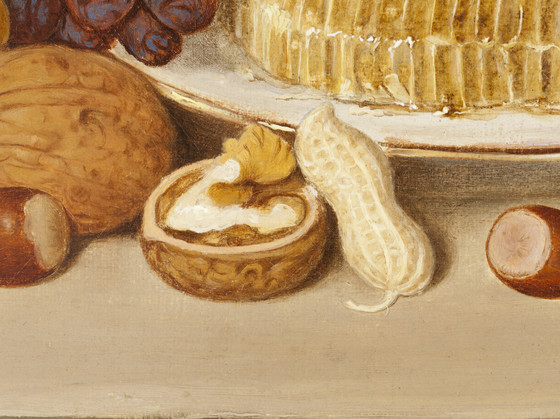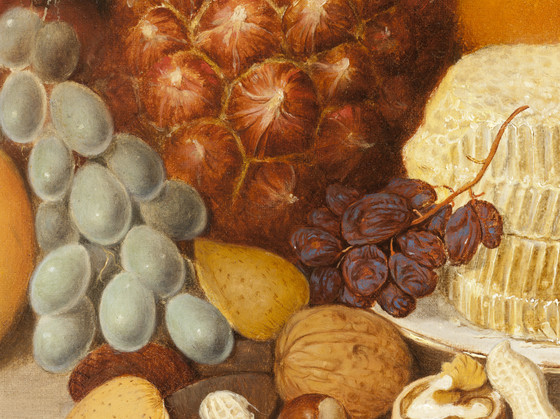Still-life paintings are rare in Duncanson’s oeuvre. Seven canvases are known today....
Still-life paintings are rare in Duncanson’s oeuvre. Seven canvases are known today. The decorations Duncanson created from 1848 to 1850 for Belmont, the home of his patron Nicholas Longworth (now the Taft Museum, Cincinnati), may have stimulated his interest in such subject matter. Although painted in a different, more rococo style, the decorative panels included two overdoor designs of fruit and flowers in vases. Longworth was not only a lawyer and a major patron of the arts but one of the finest horticulturists in America. He played a major role in the commercialization of grapes and cultivation of strawberries. However, in none of Duncanson’s located still, lifes did the artist focus on grapes. Rather, in the fashion of most still-life specialists, he included a variety of food: apples, grapes, oranges, raisins, nuts, pineapples, and honeycombs. The last two items were considered exotic and often were included in Victorian still lifes; in the South the pineapple was a symbol of hospitality.
Still Life is a transitional piece, exhibiting characteristics typical of both early- and midnineteenth-century American still-life paintings, due in part to the date of the painting and to the fact that it was painted in a frontier environment, which slightly lagged behind the East in artistic developments. In the tradition of paintings by the Peale family, the fruit and nuts are arranged on a bare, wood table with a dark background and strong lighting. Duncanson’s composition is more elaborate than the spare, neoclassical arrangements of Raphaelle Peale (1774-1825) and closer to those by James Peale (1749-1831) and younger Peale children. In fact, Sarah Miriam Peale (1800-1885) extended the Peale influence to the West when she moved to Saint Louis in 1847. The arched format was a later, more Victorian element, however, used by SEVERIN ROESEN and many other artists of the 1850s and 1860s. Two other Duncanson still-life paintings (Detroit Institute of Arts and Corcoran Gallery of Art, Washington, D.C.) have similar compositional treatments and formats. However, in these two, following mid-century fashion, the still-life elements are set on a white tablecloth rather than a bare wooden table. In complexity of arrangement, the museum’s still life seems to be midway between the Corcoran Gallery picture, the least complex, and that in the Detroit Institute, the most complex.
Duncanson exhibited his fruit still-life paintings at state fairs and art displays in Detroit, Cincinnati, and New York during the late 1840s and 1850s. While not all the exhibits can be definitely identified with known works, it is probable that the museum’s still life was shown at one time, possibly at the Western Art Union or Detroit Gallery of Fine Arts in Fireman’s Hall.
More...






